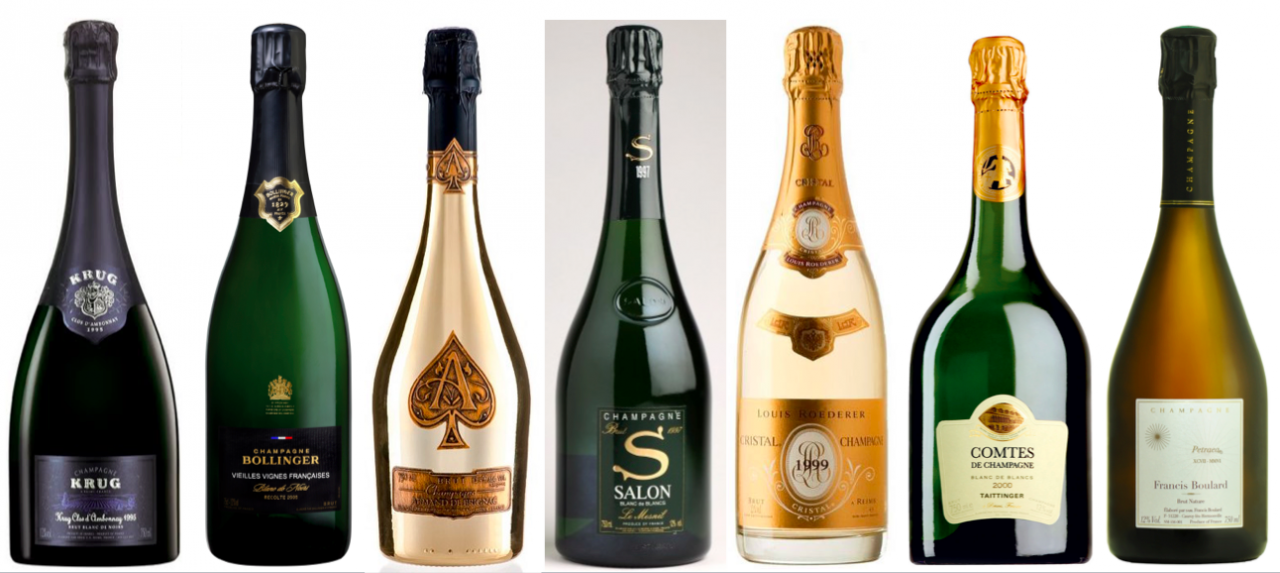
While champagne is normally considered an extravagant indulgence, it is actually incredible value for money on the typical wine list, especially when comparing to other global class wines you might select. Smart wine list have been stopping at the Champagne section of the wine list for years.
Let’s be specific, I am talking about Champagne. This is the bubbly wine from the Champagne area of France and not some of the other excellent bubbly wines from around the world like Cremant, Sekt, Cava and Franciacorta. I’ll be doing an article on those fun beverages at a later date.Technically, there are a lot of similarities between most high quality effervescent wines and Champagne, but an international accord reserves that name for grapes grown in France and in Champagne. Yes, it’s a marketing arrangement, but it does make some sense when you understand how unique that area is for these particular grapes and this wine. Most high quality bubbles are made using the Method Traditional,which used to be called Method Champenoise. This means the wine is fermented in the bottle, capturing the CO2 that makes the lovely bubbles we all enjoy. There are other techniques to getting bubbles in wine, but the gold standard is the approach developed by the blind monk, Dom Perignon.
Champagne is very northerly for the growth of grapes and hence the wines are highly acidic, lower alcohol and lean. Traditionally, it was about as far north as you could make wine, but global warming has opened the southern coast of England to sparkling wine production as well. The ground in Champagne is chalky and acidic and this gives the wines a lovely lift at the end of the taste.
The good news with all this chalky, high acid wines is that they are perfect for food. In fact, you can easily go through an entire meal, pairing strictly with Champagne. Most of us stop at a welcoming toast or perhaps through a cold fish course and forget that this bubbly drink can easily pair with pasta and meat entrees and even finish a meal with style
There are a few types to consider, but I’d recommend getting the best you can swing as the prices don’t go up that much.
Non-Vintage – a lot of the champagne you will see in your local liquor store is non-vintage. What this means is that they maker has blended grapes from a few different years, thus eliminating the ability to mark it with a particular year. This lets them maintain a house style of champagne even in years that aren’t great by bending wines from prior years. These wines are grown on extremely expensive ground, blended and aged at least 12 months on the lees and a minimum of 15 months in the bottle total.
You should be able to grab a bottle of NV champagne from a top producer like Veuve Clicquot for $40 to $70 a bottle.
Vintage – Only in exceptional years will the Champagne growers get together and declare that the wine is good enough to be vintage. This means that all of the grapes used to produce the wine are from the year indicated on the bottle. It’s usually super delicious and exhibits the house style like NV, but with that something extra from a great year. Vintage champagne is aged on the lees 36 months, giving it a toasty flavor. Each bottle is made with care in a complicated multi-step processes, each step adding cost. By rights, these should be fabulously expensive wines.
I was able to find some great vintage champagne for $85 to $150 at the local Total Wine store. At a recent meal in a fancy restaurant with clients, I was able to get a 2008 vintage champagne for only $130 (including the restaurant profits)
Tete De Cuvee – This literally means Head of the Vat, but it signifies the best of the best from a high quality producer. These wines are vintage and produced from the best parcels of premier and grand cru vineyards and only in the very best years. That means your bottle will carry a year indicating when the grapes were grown. A few excellent recent vintages include 2002,2002, 2006, 2008 and 2009. Vintages of this quality normally happen perhaps 3 times a decade (although the most recent decade had 5). Realize that these wines are aged extensively before release to the market, for example the 2008 louis Roederer Cristal is just coming out now, in 2018.
The grapes are hand selected, pressed with care and aged well beyond the minimums for vintage champagne. They are the best examples the winemaker can produce. They tend to have recognizable names like Dom Perignon, La Grande Dame and Winston Churchill.
While they aren’t cheap, they are a relative bargain. For the best wines from Burgundy or Napa or Bordeaux, you could easily spend $250 to $1000 a bottle and yet you can find global class Tete de Cuvee Champagnes for $100 to $200 a bottle.
So if you want a great bottle, without breaking the bank (compared to other epic wines), grab a vintage or Tete de Cuvee Champagne and have some fun. We can never drink enough bubbles!
Cheers!

